
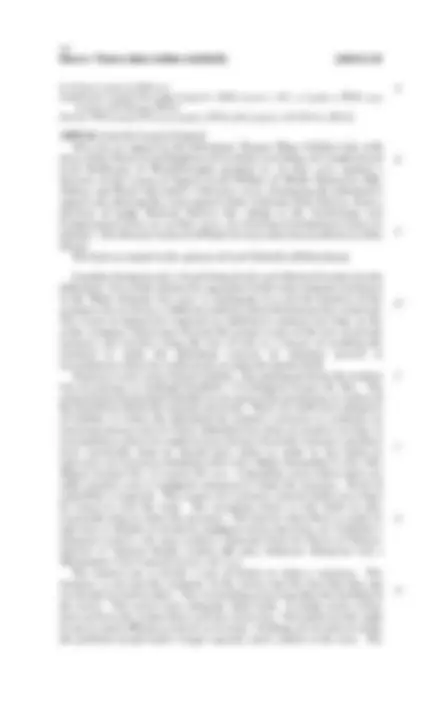
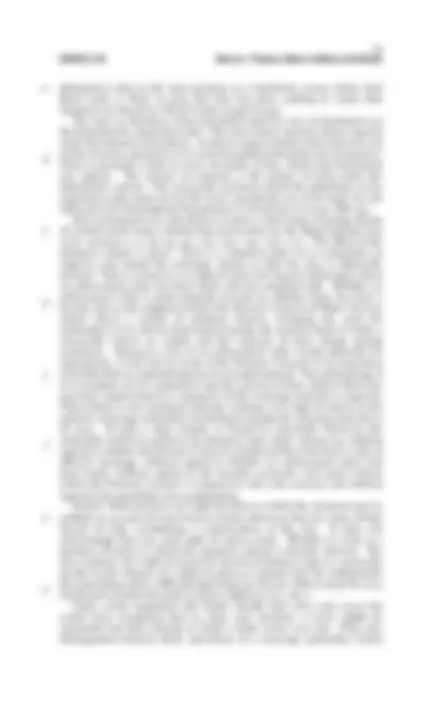
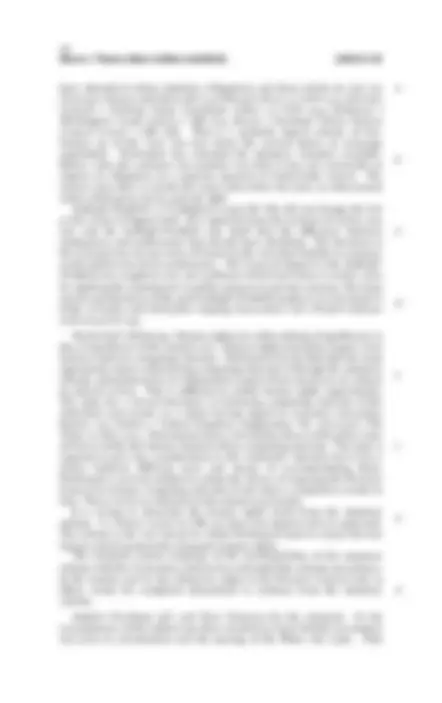




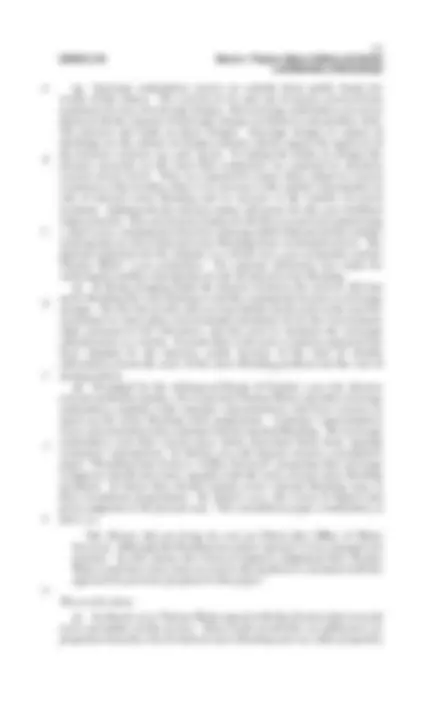

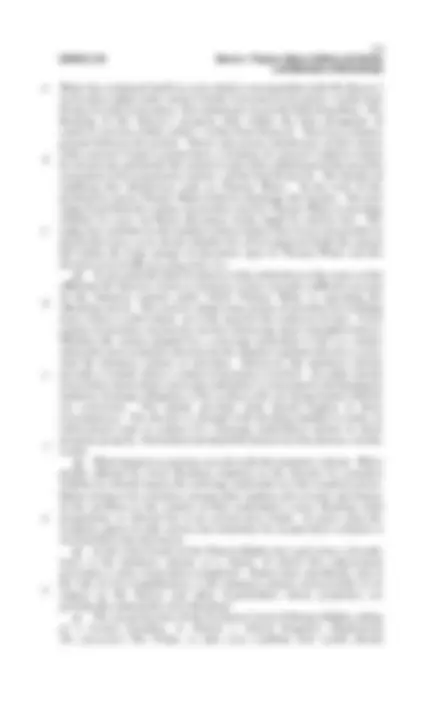
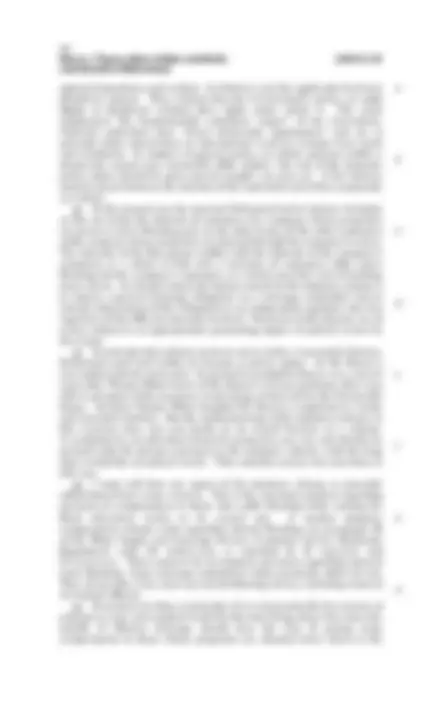

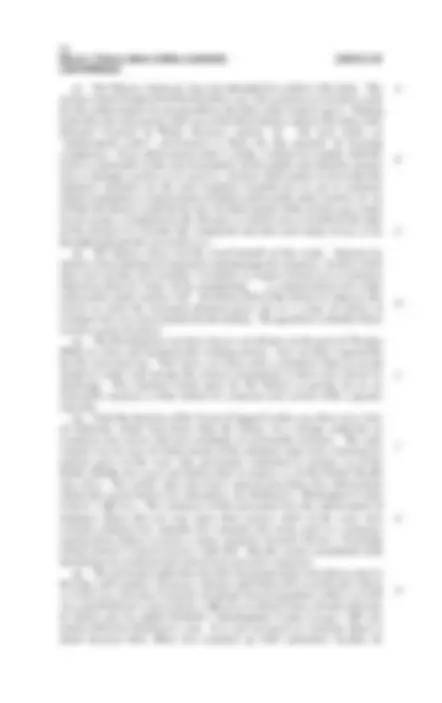

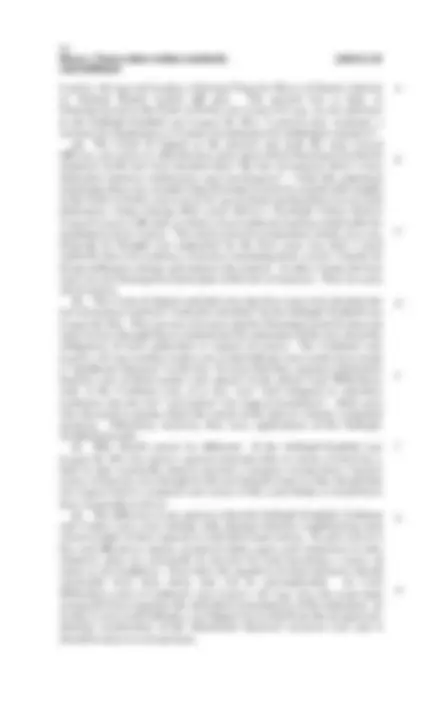






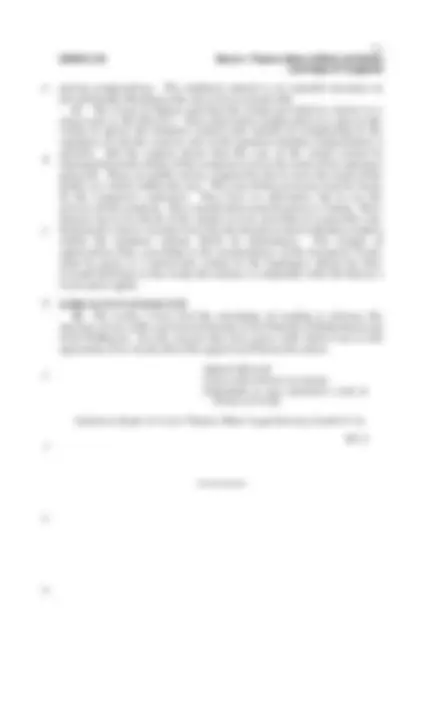


Study with the several resources on Docsity

Earn points by helping other students or get them with a premium plan


Prepare for your exams
Study with the several resources on Docsity

Earn points to download
Earn points by helping other students or get them with a premium plan
Community
Ask the community for help and clear up your study doubts
Discover the best universities in your country according to Docsity users
Free resources
Download our free guides on studying techniques, anxiety management strategies, and thesis advice from Docsity tutors
В данном документе рассматривается теоретическая база и практические применения искусственного интеллекта в медицине. Автор обсуждает различные подходы к созданию медицинских систем с искусственным интеллектом, их преимущества и ограничения. Кроме того, рассматриваются реальные примеры использования искусственного интеллекта в медицине, такие как диагностика болезней, планирование лечения и мониторинг пациентов. Документ может служить полезным для студентов, изучающих медицинскую информатику и искусственный интеллект.
What you will learn
Typology: Summaries
1 / 30

This page cannot be seen from the preview
Don't miss anything!























House of Lords
2003 Oct 27 , 28 , 29 ; Lord Nicholls of Birkenhead, Lord Steyn, Lord Homann, Dec 4 Lord Hope of Craighead and Lord Scott of Foscote
Nuisance Ñ Things naturally on land Ñ Water Ñ Sewage and surface water ßooding garden after heavy rain due to inadequate sewerage system Ñ No steps taken or planned by statutory sewerage undertaker to remedy ßooding Ñ Whether sewerage undertaker liable at common law in nuisance Ñ Whether failure to abate nuisance breaching plaintiÕs Convention rights to respect for home and enjoyment of possessions Ñ Water Industry Act 1991 (c 56 ), ss 18 , 22 , 94 Ñ Human Rights Act 1998 (c 42 ), ss 6 , 8 ( 3 ), Sch 1 , Pt I, art 8 , Pt II, art 1
Since 1992 the plaintiÕs garden had repeatedly been ßooded and his house adversely aected by sewage discharged from sewers operated and maintained by the defendant, which was the statutory sewerage undertaker under the Water Industry Act 19911 responsible for the sewers and a public authority for the purposes of section 6 of the Human Rights Act 19982. The ßooding was caused by the overloading of a section of the sewerage system which the defendant had inherited from its predecessor. When constructed that section had been adequate for the foreseeable needs of the area it served, but it had become inadequate because of increased user following the connection of third parties to the system as of right. To determine its priorities for spending money to alleviate ßooding the defendant operated a points system to balance the seriousness of a ßooding incident against the estimated cost of the necessary works. Under that system, which the defendant intended to continue using, there was no prospect of any work being done in the foreseeable future to remedy the ßooding of the plaintiÕs property although it was practicable to carry out the necessary work. In 1998 the plaintibrought an action against the defendant for damage to his property caused by escapes from the defendantÕs surface water sewers. At a hearing of preliminary issues on liability the judge held, inter alia, that the defendant was not liable at common law for its failure to carry out works to prevent a nuisance which it had neither caused nor created, but that that failure constituted an interference with the plaintiÕs right to respect for his private life and his home under article 8 ( 1 ) of the Convention for the Protection of Human Rights and Fundamental Freedoms and of his right to peaceful enjoyment of his possessions under article 1 of the First Protocol to the Convention. The Court of Appeal upheld that conclusion and additionally held that the defendant was liable in nuisance. On appeal by the defendantÑ Held, allowing that appeal, that a sewerage undertaker was subject to an elaborate scheme of regulation under the 1991 Act which included an independent regulator with powers of enforcement whose decisions were subject to judicial review; that the statutory scheme provided a procedure for making complaints to the regulator which the plaintihad chosen not to pursue; that a balance had to be struck between the interests of a person subject to sewer ßooding and the interests of those, including other customers of the sewerage undertaker, who would have to Þnance the cost of constructing more sewers; that such a balancing exercise was
A B C D E F G H
(^1) Water Industry Act 1991 , s 18 ( 8 ): see post, para 18. S 22 : see post, para 17. S 2 94 : see post, para 18. Human Rights Act 1998 , s 6 : ÔÔ( 1 ) It is unlawful for a public authority to act in a way which is incompatible with a Convention right.ÕÕ
Marcic v Thames Water Utilities Ltd (HL(E))Marcic v Thames Water Utilities Ltd (HL(E)) [2004] 2 AC[2004] 2 AC
better undertaken by an industry regulator than a court; that the common law should not impose on a sewerage undertaker obligations which would be inconsistent with the statutory scheme since that would run counter to the intention of Parliament; that a cause of action in nuisance would be inconsistent with the statutory scheme; that, given the need to balance competing interests and the availability of judicial review, the statutory scheme was compatible with the plaintiÕs rights under the Convention; and that, accordingly, the plainticould sustain neither a claim in nuisance against the defendant nor a claim under the Human Rights Act 1998 ( post, paras 33 Ð 36 , 38 Ð 39 , 42 Ð 43 , 46 Ð 48 , 61 Ð 64 , 70 Ð 73 , 77 , 81 Ð 83 , 87 Ð 88 ). Glossop v Heston and Isleworth Local Board ( 1879 ) 12 Ch D 102 , CA; Robinson v Workington Corpn [ 1897 ] 1 QB 619 , CA and Smeaton v Ilford Corpn [ 1954 ] Ch 450 applied. Sedleigh-DenÞeld v OÕCallaghan [ 1940 ] AC 880 , HL(E); Goldman v Hargrave [ 1967 ] 1 AC 645 , PC and Leakey v National Trust for Places of Historic Interest or Natural Beauty [ 1980 ] QB 485 , CA distinguished. Decision of the Court of Appeal [ 2002 ] EWCA Civ 64 ; [ 2002 ] QB 929 ; [ 2002 ] 2 WLR 932 ; [ 2002 ] 2 All ER 55 reversed.
The following cases are referred to in the opinions of their Lordships: Attorney General v Dorking Union Guardians ( 1882 ) 20 Ch D 595 , CA Baron v Portslade Urban District Council [ 1900 ] 2 QB 588 , CA Bryan v United Kingdom ( 1995 ) 21 EHRR 342 Buckley v United Kingdom ( 1996 ) 23 EHRR 101 Delaware Mansions Ltd v Westminster City Council [ 2001 ] UKHL 55 ; [ 2002 ] 1 AC 321 ; [ 2001 ] 3 WLR 1007 ; [ 2001 ] 4 All ER 737 , HL(E) Glossop v Heston and Isleworth Local Board ( 1879 ) 12 Ch D 102 , CA Goldman v Hargrave [ 1967 ] 1 AC 645 ; [ 1966 ] 3 WLR 513 ; [ 1966 ] 2 All ER 989 , PC Hatton v United Kingdom (Application No 36022 / 97 ) The Times, 10 July 2003 , ECtHR Hesketh v Birmingham Corpn [ 1924 ] 1 KB 260 , CA Holbeck Hall Hotel Ltd v Scarborough Borough Council [ 2000 ] QB 836 ; [ 2000 ] 2 WLR 1396 ; [ 2000 ] 2 All ER 705 , CA Kingsley v United Kingdom ( 2000 ) 33 EHRR 288 Leakey v National Trust for Places of Historic Interest or Natural Beauty [ 1980 ] QB 485 ; [ 1980 ] 2 WLR 65 ; [ 1980 ] 1 All ER 17 , CA Pasmore v Oswaldtwistle Urban District Council [ 1898 ] AC 387 , HL(E) Pride of Derby and Derbyshire Angling Association Ltd v British Celanese Ltd [ 1953 ] Ch 149 ; [ 1953 ] 2 WLR 58 ; [ 1953 ] 1 All ER 179 , CA R v Shayler [ 2002 ] UKHL 11 ; [ 2003 ] 1 AC 247 ; [ 2002 ] 2 WLR 754 ; [ 2002 ] All ER 477 , HL(E) Robinson v Workington Corpn [ 1897 ] 1 QB 619 , CA Sedleigh-DenÞeld v OÕCallaghan [ 1940 ] AC 880 ; [ 1940 ] 3 All ER 349 , HL(E) Smeaton v Ilford Corpn [ 1954 ] Ch 450 ; [ 1954 ] 2 WLR 668 ; [ 1954 ] 1 All ER 923
The following additional cases were cited in argument: Allen v Gulf Oil ReÞning Ltd [ 1981 ] AC 1001 ; [ 1981 ] 2 WLR 188 ; [ 1981 ] 1 All ER 353 , HL(E) Crimmins v Stevedoring Industry Finance Committee ( 1999 ) 200 CLR 1 Job Edwards Ltd v Birmingham Navigations Co Proprietors [ 1924 ] 1 KB 341 , CA Overseas Tankship (UK) Ltd v Miller Steamship Co Pty (The Wagon Mound (No 2 )) [ 1967 ] AC 617 ; [ 1966 ] 3 WLR 498 ; [ 1966 ] 2 All ER 709 , PC Pyrenees Shire Council v Day ( 1998 ) 192 CLR 330 Rae v Burgh of Musselburgh 1974 SLT 29 Runa Begum v Tower Hamlets London Borough Council [ 2003 ] UKHL 5 ; [ 2003 ] 2 AC 430 ; [ 2003 ] 2 WLR 388 ; [ 2003 ] 1 All ER 731 , HL(E)
A B C D E F G H
[2004] 2 AC[2004] 2 AC Marcic v Thames Water Utilities Ltd (HL(E))Marcic v Thames Water Utilities Ltd (HL(E))
defendant is thus in the same position as a landowner across whose land ßood water is likely to pass but who has done nothing to create that situation: see Smeaton v Ilford Corpn [ 1954 ] Ch 450. The issue is, therefore, what reasonable steps by way of abatement can the defendant be required to take? The only answer must be: those required under the statutory procedures. A duty to acquire further land and carry out works of sewer expansion on it cannot be deduced from the law of nuisance. That is essentially a duty to carry out public works, which only Parliament can impose. The essence of nuisance is the misuse of land under the defendantÕs control. The reasonable measures which the defendant can be required to take must involve the more considerate use of his land: see Job Edwards Ltd v Birmingham Navigations Co Proprietors [ 1924 ] 1 KB 341. Since privatisation in 1989 there is in place a much more exacting scheme of control of the water industry than previously; see the Water Industry Act 1991 , sections 2 , 6 , 18 , 94 , 95 , 106 , 142 , 143 , 155 , 219. The eect of the statutory scheme is plain. There is a statutory duty on an undertaker to improve and extend the sewerage system so that his area is eectually drained. There is, however, no right of action for breach of that duty unless an enforcement order has been made and not complied with. Whether an enforcement order is made depends not just on whether there has been a breach, but on the judgment which the Director General of Water Services makes about a variety of statutory factors, including the need for undertakers to be able to fund improvements, the need for them to make a reasonable return on capital and the interests of their charge paying customers. Moreover, even if an enforcement order would otherwise be appropriate, it will not be made if the Director General in his discretion concludes that an undertaking may be accepted instead. The undertaking, if it is accepted, can be expected to specify a period of time within which any necessary improvement or expansion of the sewerage network is required. That scheme is not consistent with the existence of a right of action in tort against a sewerage undertaker for failing to enlarge the sewerage network in its area. If such a duty existed, it would be actionable whenever the undertaker failed to perform his statutory duty under section 94 , without regard to whether the Director General considered there had been a lack of eective drainage, without regard to whether an enforcement order had been made, without regard to the broader economic and social criteria which the Director General is required to take into account and without regard to the possibility of an undertaking. Section 18 ( 8 ) preserves any right of action to which the claimant may be entitled on account of some breach of duty otherwise than by virtue of that breach of duty constituting a contravention of the Act. It does not acknowledge that any such right of action exists. Whether it exists is a question of policy to which the statutory scheme is directly relevant. The non existence of a right of action for breach of statutory duty is a powerful pointer to the absence of a right of action at common law for substantially the same thing under a dierent legal label: see Stovin v Wise [ 1996 ] AC 923 ; Southwark London Borough Council v Mills [ 2001 ] 1 AC 1. Under earlier legislation (the Public Health Acts 1875 and 1935 ) the courts have recognised that to clean and maintain a sewer might be actionable but that refusing to build a better sewer was not. They also distinguished between those operations of a sewerage undertaker which
A B C D E F G H
[2004] 2 AC[2004] 2 AC Marcic v Thames Water Utilities Ltd (HL(E))Marcic v Thames Water Utilities Ltd (HL(E))
have attached to them statutory obligations and those which do not: see Glossop v Heston and Isleworth Local Board ( 1879 ) 12 Ch D 102 ; Attorney General v Dorking Union Guardians ( 1882 ) 20 Ch D 595 ; Robinson v Workington Corpn [ 1897 ] 1 QB 619 ; Baron v Portslade Urban District Council [ 1900 ] 2 QB 588. That is a perfectly logical scheme of law. Section 94 of the 1991 Act lays down the current duties on sewerage undertakes. Parliament has extended the statutory remedies available. Before 1989 the common law position was that it was not reasonable to impose an obligation on a separate operator to build better sewers. The answer since then is exactly the same unless there has been an enforcement notice which gives rise to a private right. Sedleigh-DenÞeld v OÕCallaghan [ 1940 ] AC 880 did not change the law as the Court of Appeal held. It is apparent from the analysis of earlier case law and the Sedleigh-DenÞeld case itself that the dierence between misfeasance and nonfeasance had already been abolished. The decisions in the Glossop line of cases were all based on the view that liability in nuisance could indeed arise from nonfeasance. The Court of Appeal in the Sedleigh- DenÞeld case sought to iron out confusion which had arisen in earlier cases by applying the existing law in public nuisance to private nuisance The most recent consideration of the post Sedleigh-DenÞeld position is to be found in Pride of Derby and Derbyshire Angling Association Ltd v British Celanese Ltd [ 1953 ] Ch 149.
Pannick QC following. Human rights law adds nothing of signiÞcance in the circumstances of the instant case. Human rights principles require a fair balance between competing interests. Parliament has decided that the most appropriate means of balancing competing interests is through the statutory scheme, administered by an independent expert whose decisions are subject to judicial review. This is su±cient to satisfy human rights requirements. The state has a broad discretion in balancing competing interests of the individual and society as a whole having regard to economic and policy factors: see Hatton v United Kingdom (Application No 36022 / 97 ) The Times 10 July 2003. Parliament enjoys a broad discretion on the policy issue of how to strike the balance between those competing interests. The state is required to give due consideration to the claimantÕs interests but it has a choice between dierent ways and means of accommodating them. Parliament is at least entitled to adopt the choice of requiring the Director General to balance competing interests if and when a complaint is made to him. There can be no objection to the scheme in principle. It is wrong to dissociate the human rights claim from the statutory scheme. S v France ( 1990 ) 65 DR 250 does not support such an approach. The scheme is the very means by which Parliament seeks to ensure the fair balance which protects the claimantÕs human rights. The claimant cannot complain of the incompatibility of the statutory scheme with the Convention until he has exhausted the schemes procedures. In the instant case he has refused to apply to the Director General and, in eect, wants his complaint determined in isolation from the statutory scheme.
Stephen Hockman QC and Peter Harrison for the claimant. In the circumstances of the instant case there would have been liability at common law prior to privatisation and the passing of the Water Act 1989. That
A B C D E F G H
Marcic v Thames Water Utilities Ltd (HL(E))Marcic v Thames Water Utilities Ltd (HL(E)) [2004] 2 AC[2004] 2 AC
Those steps do not necessarily entail land acquisition. The courts below have correctly held that the defendant failed to comply with this duty. The Court of Appeal was also correct to hold that damages would be payable even if reasonable steps were taken. The line of cases beginning with Glossop v Heston and Isleworth Local Board 12 Ch D 102 has no real bearing on the question whether the common law and the statutory scheme can co-exist as no liability at common law was found to exist on the facts. Indeed, those cases support the idea that the two can co-exist. In Smeaton v Ilford Corpn [ 1954 ] Ch 450 there was no discussion about the building of new sewers or the reasonableness of doing so. Nor was there any discussion of reasonable steps. Rae v Burgh of Musselburgh 1974 SLT 29 can be distinguished as, inter alia, no common law claim was in play. For the original tortfeasor there may be a defence of statutory authorization, but it is narrowly deÞned: see Allen v Gulf Oil ReÞning Ltd [ 1981 ] AC 1001. If clear words are needed to create an express statutory liability then express words must be needed to exclude common law liability. The proposition that the 1991 Act created an immunity to common law liability is expressly negated by section 18 ( 8 ). In relation to liability under the principle in the Sedleigh-DenÞeld case [ 1940 ] AC 880 there is little or no scope for the application of the defence of statutory authority. In general the extent to which a common law duty may be displaced by a concurrent statutory duty or power will vary: see Stovin v Wise [ 1996 ] AC 923 , 938 , per Lord Nicholls of Birkenhead. The instant case lies at the edge of the spectrum. Recent Commonwealth cases show that what Lord Nicholls called a ÔÔconcurrent common law dutyÕÕ will arise where ( 1 ) the public authority had the statutory power to protect a speciÞc class, to which the claimant belongs, from the risk of harm; ( 2 ) the claimant was especially vulnerable in the sense that he could not reasonably be expected adequately to protect himself against that risk; ( 3 ) the public authority had knowledge of that risk and the power to control or at least minimise that risk. If those factors exist in combination, the authority will owe the claimant a common law duty to exercise the statutory power: see Pyrenees Shire Council v Day ( 1998 ) 192 CLR 330 and Crimmins v Stevedoring Industry Finance Committee ( 1999 ) 200 CLR 1. Those three factors apply in the instant case. The mere fact that common law liability may give rise to Þnancial consequences which are dierent from, and more onerous than, those which arise under the statutory scheme cannot be an objection. The statutory scheme exists in part to ensure that sewerage undertakers are able to recover their reasonable costs from the community at large. The fact that the cost will be so widely spread is a point in favour of allowing for common law liability. The consequences for the defendant of such liability have been recognized by the Director General in a consultation paper: see Flooding from SewersÑA Way Forward ( 2002 ), especially at p 9. The aim of the 1991 Act is to ensure that an area is eectually drained: see section 94. That is in itself no guarantee that in the process a nuisance will not be created in consequence of the activities of those responsible for the drainage. The statutory duty is for the beneÞt of the public generally. The tortious duty is for the protection of particular individuals. The fulÞlment of the
A B C D E F G H
Marcic v Thames Water Utilities Ltd (HL(E))Marcic v Thames Water Utilities Ltd (HL(E)) [2004] 2 AC[2004] 2 AC
common law duty does not detract from but rather enhances the fulÞlment of the statutory duty. When considering the human rights issues the Court of Appeal operated on the basis that there was liability in domestic law. On the assumption that there is no common law liability new issues arise. After the decision of the European Court of Human Rights in Hatton v United Kingdom (Application No 36022 / 97 ) it is clear that the crucial issue is the structure of the statutory scheme. Much is made of the fact that the decision has been made by one public authority and approved by a second public authority, the Director General. One should, however, look at how the statutory scheme works and whether the procedural safeguards in place are adequate: see Runa Begum v Tower Hamlets London Borough Council [ 2003 ] 2 AC 430. It is clear on the evidence that any claim by the claimant to the Director General would have made no dierence to the outcome. It is for our courts to assess whether a fair balance has been struck between competing interests. Looking at the situation from the claimantÕs point of view, it can be seen that the outcome is such an aront to the conscience that there should be a remedy. Sumption QC in reply. The decision in Pyrenees Shire Council v Day 192 CLR 330 is wholly orthodox in English terms. Crimmins v Stevedoring Industry Finance Committee 200 CLR 1 appears to move away from the reasoning in Stovin v Wise [ 1996 ] AC 923. Australia seems to be moving away from the English approach. However, every case acknowledges that the existence of a common law duty must be consistent with the statute. The statutory scheme under the 1991 Act is a response to a problem. The beneÞt of a having a regulator is that he can make decisions with a broad view of the implications for all parties concerned. That is precisely how such a system ought to work. Decisions depending on general considerations aecting the community at large are not suitable for a court. Hatton v United Kingdom (Application No 36022 / 97 ) shows that the European Court of Human Rights takes a broad view. It has regard to more that just the position of the claimant. A statutory scheme involving a regulator is acceptable. Consequently, the issue becomes whether the scheme is an adequate system for achieving a fair balance between the competing interests of the individual and the community as a whole. In enacting the 1991 Act Parliament put in place a system which strikes the appropriate balance. The claimant in the instant case is in a better position than the applicant in Runa Begum v Tower Hamlets London Borough Council [ 2003 ] 2 AC 430 as he can make a complaint to a regulator. In any event the instant case is not an article 6 complaint. The claimant had a right to complain to the Director General. If he did so and was dissatisÞed he could apply for judicial review. Judicial review is a satisfactory system for overseeing the Director GeneralÕs decisions: see Bryan v United Kingdom ( 1995 ) 21 EHRR 342. The Director General of Water Services made written submissions.
Their Lordships took time for consideration.
4 December. LORD NICHOLLS OF BIRKENHEAD 1 My Lords, this appeal concerns ßooding of a particularly unpleasant kind: from foul water sewers as well as surface water sewers. Sewer ßooding is a nationwide environmental problem, arising largely from the building of
A B C D E F G H
[2004] 2 AC[2004] 2 AC Marcic v Thames Water Utilities Ltd (HL(E))Marcic v Thames Water Utilities Ltd (HL(E)) Lord Nicholls of BirkenheadLord Nicholls of Birkenhead
bring about one of these ßooding incidents. But the position deteriorated. By 2001 15 minutes of heavy rain or some hours of steady drizzle were su±cient. 7 When these ßooding incidents occur the water reaches the brick walls of Mr MarcicÕs house, above as well as below the level of the damp course, often rising to within an inch of the level of the front door threshold. The house is aected by damp and subsidence and may have been damaged structurally. Mr Marcic constructed his own ßood defence system in his front garden, at a cost of £ 16 , 000. To an extent this alleviated the damage. It is these works alone which prevented ßoodwater from entering his home. But the only eective solution is enlarging or extending the existing public sewerage system. New public surface water sewers are needed to provide additional capacity to cope with heavy rainfall. 8 Mr Marcic complained to his local authority in June 1992. Thereafter, despite repeated eorts by him to get something done, no steps were taken to remedy the underlying cause. The history is summarised by Judge Richard Havery QC: [ 2002 ] QB 929 , 937 Ð 939 , paras 12 Ð 16. Mr Marcic started these court proceedings in May 1998. The defendant, Thames Water Utilities Ltd, is the statutory sewerage undertaker for the area which includes Old Church Lane. Mr Marcic sought an injunction restraining Thames Water from permitting the use of its sewerage system in such a way as to cause ßooding to 92 Old Church Lane, a mandatory order compelling Thames Water to improve the sewerage system, and damages. 9 Thames Water operates its sewerage system under statutory powers and subject to statutory duties. In these proceedings, for a reason which will become apparent, Mr Marcic has not sought to rely directly on any alleged contraventions by Thames Water of its statutory obligations. Instead Mr Marcic asserts ( 1 ) a common law claim in nuisance and ( 2 ) a claim under the Human Rights Act 1998 that Thames Water as a public authority has acted incompatibly with his Convention rights under article 8 (respect for family life and home) and article 1 of the First Protocol ( protection of property). At a trial of preliminary issues Judge Richard Havery, sitting in the Technology and Construction Court, rejected the former claim and others (not now pursued) but upheld the latter. On appeal the Court of Appeal, comprising Lord Phillips of Worth Matravers MR, Aldous and Ward LJJ, found in favour of Mr Marcic on both claims ( 1 ) and ( 2 ): [ 2002 ] QB 929. Thames Water has appealed against that decision.
The statutory scheme 10 The starting point for any consideration of Thames WaterÕs obligations and liabilities must be the statutory scheme under which it operates the sewers in question. Sewage disposal and drainage have been the subject of statutory regulation for 500 years. The Þrst public general Act was the Statute of Sewers 1531 ( 23 Hen 8 , c 5 ). But the systematic construction of extensive networks of public sewers dates largely from the middle of the 19 th century and was the responsibility of public water undertakers. Until comparatively recently public water undertakers were usually local authorities. The Water Act 1989 provided for the transfer of most of the statutory functions of the existing public water authorities to privatised water and sewage undertakers. These were regulated commercial
A B C D E F G H
[2004] 2 AC[2004] 2 AC Marcic v Thames Water Utilities Ltd (HL(E))Marcic v Thames Water Utilities Ltd (HL(E)) Lord Nicholls of BirkenheadLord Nicholls of Birkenhead
companies, having broadly the same statutory powers and duties as the authorities they replaced. 11 The current legislation comprises the Water Industry Act 1991. This statute consolidated the relevant provisions of the Water Act 1989. The 1991 Act sets out the powers and duties of both water undertakers and sewerage undertakers. The exercise of these functions is subject to supervision and control by the Director General of Water Services. Thames Water is a commercial company carrying on business as a public sewerage undertaker within this statutory framework. It is one of ten appointed sewerage undertakers. Its appointed area is huge, extending from Cirencester to Brentwood and from Banbury to Crawley. It is responsible for 80 , 000 kilometres of public sewers of varying sizes, serving 5. 4 million connected properties and a population of 12 million. 12 The 1991 Act is extensive and I shall mention only the provisions of direct relevance to the issues arising in these proceedings. Part I of the Act makes provision for the o±ce of Director General of Water Services. He is appointed by the Secretary of State. Section 2 imposes on the Secretary of State and on the director, to use the statutory abbreviation of his title, wide ranging duties of a general character regarding the water industry. In short, the director is the regulator of the water industry in England and Wales. He is required to exercise and perform his statutory powers and duties in the manner he considers best calculated to secure that the functions of a water undertaker and a sewerage undertaker are properly carried out. This duty includes ensuring that companies appointed as sewerage undertakers are able, by securing reasonable returns on their capital, to Þnance the proper carrying out of their functions. Commercial companies cannot be expected to take up appointments as sewerage undertakers unless there is a prospect of obtaining a reasonable rate of return on their invested capital. The director is also required to protect the interests of customers of sewerage undertakers in respect of sewerage undertakersÕdrainage charges and in other respects. 13 Sections 18 to 22 of the Act make provision for enforcement orders. Enforcement orders are a means by which the Secretary of State and the director enforce the obligations of a sewerage undertaker. These provisions are of central importance in the present case. So far as the present case is concerned their eect is as follows. Where the director is satisÞed that a sewerage undertaker is contravening a statutory requirement enforceable under section 18 he ÔÔshallÕÕ by a Þnal enforcement order make requisite provision for the purpose of securing compliance with that requirement: section 18 ( 1 ). In certain circumstances, instead of taking steps towards making a Þnal enforcement order, the director has power to make a provisional enforcement order: section 18 ( 2 ) and ( 3 ). A company is required to comply with an enforcement order, whether Þnal or provisional: section 18 ( 5 ). 14 Where contravention of a statutory requirement is enforceable under section 18 , section 18 ( 8 ) limits the availability of other remedies:
ÔÔ( 8 ) Where any act or omission constitutes a contravention of... a statutory or other requirement enforceable under this section, the only remedies for that contravention, apart from those available by virtue of this section, shall be those for which express provision is made by or
A B C D E F G H
Marcic v Thames Water Utilities Ltd (HL(E))Marcic v Thames Water Utilities Ltd (HL(E)) [2004] 2 AC[2004] 2 AC Lord Nicholls of BirkenheadLord Nicholls of Birkenhead
recent years is compatible with Old Church Lane being eectually drained. Mr MarcicÕs di±culty on this point lies elsewhere. 21 Mr MarcicÕs di±culty is this. Section 94 ( 3 ) provides, so far as relevant, that a sewerage undertakerÕs duty to provide an adequate system of public sewers under section 94 ( 1 ) is enforceable by the director under section 18 , in accordance with a general authorisation given by the Secretary of State. Hence, as provided in section 18 , the remedy in respect of a contravention of the sewerage undertakerÕs general drainage obligation lies solely in the enforcement procedure set out in section 18. Thus, a person who sustains loss or damage as a result of a sewerage undertakerÕs contravention of his general duty under section 94 has no direct remedy in respect of the contravention. A person in the position of Mr Marcic can bring proceedings against a sewerage undertaker in respect of its failure to comply with an enforcement order if such an order has been made. In the absence of an enforcement order his only legal remedy is, where appropriate, to pursue judicial review proceedings against the director or the Secretary of State, who has similar enforcement functions regarding section 94 , in respect of any alleged failure by the director or the Secretary of State to make an enforcement order as required by section 18 ( 1 ). 22 In the present case no enforcement order has been made against Thames Water in respect of the inadequate drainage of Mr MarcicÕs property. Nor has Mr Marcic advanced a complaint that by not making such an order the director is in dereliction of his duty under section 18. Indeed, Mr Marcic seems to have made no complaint of any sort to the director, although his opportunities in this regard were drawn to his solicitorsÕattention early in 1998. Rather, in advancing claims based on common law nuisance and under the Human Rights Act 1998 , Mr Marcic seeks to sidestep the statutory enforcement code. He asserts claims not derived from section 94 of the 1991 Act. Since the claims asserted by him do not derive from a statutory requirement, section 18 ( 8 ) does not rule them out even though the impugned conduct, namely, failure to drain the district properly, is on its face a contravention of Thames WaterÕs general statutory duty under section 94. The closing words of section 18 ( 8 ) expressly preserve remedies for any causes of action which are available in respect of an act or omission otherwise than by virtue of its being a contravention of a statutory requirement enforceable under section 18.
Providing more sewers
23 The House has had the advantage of receiving written submissions from the director on the Þnancial implications of carrying out remedial work. The cost per property of removing the risk of sewer ßooding varies widely, from as little as £ 5 , 000 to more than £ 200 , 000 , depending on the scale and nature of the necessary work. On average the cost per property is between £ 50 , 000 and £ 70 , 000. The trial judge found that the cost of alleviating the ßooding problems of all customers in Thames WaterÕs area who are in a similar position to Mr Marcic or whose properties are at risk of internal sewer ßooding at least once every ten years would be £ 1 billion. That estimate takes no account of future house building. The trial judge also found that under the prevailing system of priorities there was no prospect of any work being carried out in the foreseeable future to prevent ßooding of Mr MarcicÕs property.
A B C D E F G H
Marcic v Thames Water Utilities Ltd (HL(E))Marcic v Thames Water Utilities Ltd (HL(E)) [2004] 2 AC[2004] 2 AC Lord Nicholls of BirkenheadLord Nicholls of Birkenhead
24 Sewerage undertakers receive no subsidy from public funds for works of this nature. The cost has to be met out of money received from customers by way of sewerage charges. But sewerage undertakers are not at liberty to Þx the amount of sewerage charges at whatever amount they wish. The director sets limits on these charges. Sewerage charges in respect of dwellings are the subject of charges schemes which require the approval of the director: sections 142 and 143 ( 6 ). In setting the limits on charges the director proceeds on the basis that companies are expected to maintain current service levels. They are expected to ensure that, subject to annual variations in the weather, there is no increase in the number of properties at risk of internal sewer ßooding and no increase in the number of actual incidents. Additionally the director makes allowance for the cost of deÞned improvements. The current price limits, for the Þve year period commencing 1 April 2000 , included provision for reducing within that period the number of properties at risk of internal sewer ßooding from overloaded sewers. The planned reduction for the industry as a whole was 3 , 500 properties and for Thames Water 1 , 500 properties. No separate allowance was made for reducing the number of properties at risk of external sewer ßooding. 25 In Þxing charging limits the director balances the need to alleviate sewer ßooding, the cost of doing so and the consequent increase in sewerage charges. He also has to take into account further needs such as the need for investment to meet other environmental standards set by the Government, often pursuant to EU Directives, and the need to maintain the sewerage infrastructure as a whole. It seems that in the past a cautious approach has been adopted by the director, partly because of the lack of reliable information about the scale of the sewer ßooding problem and the cost of dealing with it. 26 Prompted by the widespread ßoods of October 2000 the director carried out further studies. For some time Thames Water and other sewerage undertakers, together with customer representatives, had been anxious to speed up the sewer ßooding relief programme. Customer representatives were concerned that some customers faced repeated ßooding. The sewerage undertakers said that current price limits prevented them from meeting customersÕexpectations. In March 2002 the director issued a consultation paper ÔÔFlooding from SewersÑA Way ForwardÕÕ proposing that sewerage companies should deal more speedily with the more serious sewer ßooding problems. In future they should include severe external ßooding cases in their investment programmes. By March 2002 , the Court of Appeal had given judgment in the present case. The consultation paper commented, at para 2. 9 :
ÔÔMr Marcic did not bring his case to Ofwat [the O±ce of Water Services]. Although the ßooding was solely external, it was repeated and extreme. To this extent, the Court of AppealÕs judgement that Thames Water could have done more to resolve the problem is consistent with the approach to priorities proposed in this paper.ÕÕ
The work is done 27 In March 2002 Thames Water agreed with the director that it would carry out further works at once. These works would free an additional 250 properties from the risk of internal sewer ßooding and 250 other properties
A B C D E F G H
[2004] 2 AC[2004] 2 AC Marcic v Thames Water Utilities Ltd (HL(E))Marcic v Thames Water Utilities Ltd (HL(E)) Lord Nicholls of BirkenheadLord Nicholls of Birkenhead
Oswaldtwistle Urban District Council [ 1898 ] AC 387. The courts have consistently followed this view of the law in relation to the Public Health Act 1875 and in relation to the Public Health Act 1936 : see, for instance, Hesketh v Birmingham Corpn [ 1924 ] 1 KB 260 and Smeaton v Ilford Corpn [ 1954 ] 1 Ch 450. In both these cases the court expressly rejected a claim for nuisance: see Scrutton LJ in the Birmingham case, at pp 271 Ð 272 , and Upjohn J in the Ilford case, at p 463. 32 In the present case the Court of Appeal felt able to reach a dierent conclusion on the scope of the remedies available to Mr Marcic. They held that the Glossop line of cases, if and in so far as they dealt with claims in nuisance, cannot survive recent developments in the common law of nuisance. The old distinction between misfeasance and non-feasance no longer rules the day. Goldman v Hargrave [ 1967 ] 1 AC 645 and Leakey v National Trust for Places of Historic Interest or Natural Beauty [ 1980 ] QB 485 , building on the decision in the leading case of Sedleigh-DenÞeld v OÕCallaghan [ 1940 ] AC 880 , establish that occupation of land carries with it a duty to oneÕs neighbour. An occupier must do whatever is reasonable in all the circumstances to prevent hazards on his land, however they may arise, from causing damage to a neighbour. In GoldmanÕs case a redgum tree in Western Australia was struck by lightning and set on Þre. The Þre spread to neighbouring property. In LeakeyÕs case natural causes were responsible for soil collapsing onto neighbouring houses in Bridgwater, Somerset. In both cases the landowners were held liable to their neighbours for the damage caused. A similar approach was adopted regarding loss of support due to a land slip in Holbeck Hall Hotel Ltd v Scarborough Borough Council [ 2000 ] QB 836 and incursion of tree roots in Delaware Mansions Ltd v Westminster City Council [ 2002 ] 1 AC 321. In the present case the Court of Appeal said [ 2002 ] QB 929 , 994 , para 83 :
ÔÔThe sewers form part of a system which Thames are operating as a commercial venture in order to make proÞts for their shareholders. Thames are in no more favourable position than a landowner on whose property a hazard accumulates by the act of a trespasser or of nature. At all material times Thames have had, or should have had, knowledge of the hazard. If the principles identiÞed in the Goldman [ 1967 ] 1 AC 645 and Leakey [ 1980 ] QB 485 cases are applied, these facts placed Thames under a duty to Mr Marcic to take such steps as, in all the circumstances, were reasonable to prevent the discharge of surface and foul water onto Mr MarcicÕs property.ÕÕ
33 I must respectfully part company with the Court of Appeal. The Goldman and Leakey cases exemplify the standard of conduct expected today of an occupier of land towards his neighbour. But Thames Water is no ordinary occupier of land. The public sewers under Old Church Lane are vested in Thames Water pursuant to the provisions of the 1991 Act, section 179 , as a sewerage undertaker. Thames WaterÕs obligations regarding these sewers cannot sensibly be considered without regard to the elaborate statutory scheme of which section 179 is only one part. The common law of nuisance should not impose on Thames Water obligations inconsistent with the statutory scheme. To do so would run counter to the intention of Parliament as expressed in the Water Industry Act 1991.
A B C D E F G H
[2004] 2 AC[2004] 2 AC Marcic v Thames Water Utilities Ltd (HL(E))Marcic v Thames Water Utilities Ltd (HL(E)) Lord Nicholls of BirkenheadLord Nicholls of Birkenhead
34 In my view the cause of action in nuisance asserted by Mr Marcic is inconsistent with the statutory scheme. Mr MarcicÕs claim is expressed in various ways but in practical terms it always comes down to this: Thames Water ought to build more sewers. This is the only way Thames Water can prevent sewer ßooding of Mr MarcicÕs property. This is the only way because it is not suggested that Thames Water failed to operate its existing sewage system properly by not cleaning or maintaining it. Nor can Thames Water control the volume of water entering the sewers under Old Church Lane. Every new house built has an absolute right to connect. Thames Water is obliged to accept these connections: section 106 of the 1991 Act. A sewerage undertaker is unable to prevent connections being made to the existing system, and the ingress of water through these connections, even if this risks overloading the existing sewers. But, so Mr MarcicÕs claim runs, although Thames Water was operating its existing system properly, and although Thames Water had no control over the volume of water entering the system, it was within Thames WaterÕs power to build more sewers, as the company now has done, to cope with the increased volume of water entering the system. Mr Marcic, it is said, has a cause of action at law in respect of Thames WaterÕs failure to construct more sewers before it eventually did in June 2003. 35 The di±culty I have with this line of argument is that it ignores the statutory limitations on the enforcement of sewerage undertakersÕdrainage obligations. Since sewerage undertakers have no control over the volume of water entering their sewerage systems it would be surprising if Parliament intended that whenever sewer ßooding occurs, every householder whose property has been aected can sue the appointed sewerage undertaker for an order that the company build more sewers or pay damages. On the contrary, it is abundantly clear that one important purpose of the enforcement scheme in the 1991 Act is that individual householders should not be able to launch proceedings in respect of failure to build su±cient sewers. When ßooding occurs the Þrst enforcement step under the statute is that the director, as the regulator of the industry, will consider whether to make an enforcement order. He will look at the position of an individual householder but in the context of the wider considerations spelled out in the statute. Individual householders may bring proceedings in respect of inadequate drainage only when the undertaker has failed to comply with an enforcement order made by the Secretary of State or the director. The existence of a parallel common law right, whereby individual householders who suer sewer ßooding may themselves bring court proceedings when no enforcement order has been made, would set at nought the statutory scheme. It would eectively supplant the regulatory role the director was intended to discharge when questions of sewer ßooding arise. 36 For this reason I consider there is no room in this case for a common law cause of action in nuisance as submitted by Mr Marcic and held by the Court of Appeal. On this point I agree with the decision of Judge Richard Havery.
The claim under the Human Rights Act 1998
37 I turn to Mr MarcicÕs claim under the Human Rights Act 1998. His claim is that as a public authority within the meaning of section 6 of the Human Rights Act 1998 Thames Water has acted unlawfully. Thames
A B C D E F G H
Marcic v Thames Water Utilities Ltd (HL(E))Marcic v Thames Water Utilities Ltd (HL(E)) [2004] 2 AC[2004] 2 AC Lord Nicholls of BirkenheadLord Nicholls of Birkenhead
approach questions such as these. In HattonÕs case the applicants lived near Heathrow airport. They claimed that the GovernmentÕs policy on night ßights at Heathrow violated their rights under article 8. The court emphasised ÔÔthe fundamentally subsidiary natureÕÕ of the Convention. National authorities have ÔÔdirect democratic legitimationÕÕ and are in principle better placed than an international court to evaluate local needs and conditions. In matters of general policy, on which opinions within a democratic society may reasonably dier widely, ÔÔthe role of the domestic policy maker should be given special weightÕÕ: see para 97. A fair balance must be struck between the interests of the individual and of the community as a whole. 42 In the present case the interests Parliament had to balance included, on the one hand, the interests of customers of a company whose properties are prone to sewer ßooding and, on the other hand, all the other customers of the company whose properties are drained through the companyÕs sewers. The interests of the Þrst group conßict with the interests of the companyÕs customers as a whole in that only a minority of customers suer sewer ßooding but the companyÕs customers as a whole meet the cost of building more sewers. As already noted, the balance struck by the statutory scheme is to impose a general drainage obligation on a sewerage undertaker but to entrust enforcement of this obligation to an independent regulator who has regard to all the dierent interests involved. Decisions of the director are of course subject to an appropriately penetrating degree of judicial review by the courts. 43 In principle this scheme seems to me to strike a reasonable balance. Parliament acted well within its bounds as policy maker. In Mr MarcicÕs case matters plainly went awry. It cannot be acceptable that in 2001 , several years after Thames Water knew of Mr MarcicÕs serious problems, there was still no prospect of the necessary work being carried out for the foreseeable future. At times Thames Water handled Mr MarcicÕs complaint in a tardy and insensitive fashion. But the malfunctioning of the statutory scheme on this occasion does not cast doubt on its overall fairness as a scheme. A complaint by an individual about his particular case can, and should, be pursued with the director pursuant to the statutory scheme, with the long stop availability of judicial review. That remedial avenue was not taken in this case. 44 I must add that one aspect of the statutory scheme as presently administered does cause concern. This is the uncertain position regarding payment of compensation to those who suer ßooding while waiting for ßood alleviation works to be carried out. A modest statutory compensation scheme exists regarding internal ßooding: see paragraph 7 B of the Water Supply and Sewerage Services (Customer Service Standards) Regulations 1989 (SI 1989 / 1159 ), as amended by SI 1993 / 500 and SI 2000 / 2301. There seems to be no statutory provision regarding external sewer ßooding. Some sewerage undertakers make payments, others do not. They all provide a free clean up and disinfecting service, including removal of residual eÂuent. 45 It seems to me that, in principle, if it is not practicable for reasons of expense to carry out remedial works for the time being, those who enjoy the beneÞt of eective drainage should bear the cost of paying some compensation to those whose properties are situated lower down in the
A B C D E F G H
Marcic v Thames Water Utilities Ltd (HL(E))Marcic v Thames Water Utilities Ltd (HL(E)) [2004] 2 AC[2004] 2 AC Lord Nicholls of BirkenheadLord Nicholls of Birkenhead
catchment area and who, in consequence, have to endure intolerable sewer ßooding, whether internal or external. As the Court of Appeal noted, the ßooding is the consequence of the beneÞt provided to those making use of the system: [ 2002 ] QB 929 , 1001 , para 113. The minority who suer damage and disturbance as a consequence of the inadequacy of the sewerage system ought not to be required to bear an unreasonable burden. This is a matter the director and others should reconsider in the light of the facts in the present case. 46 For these reasons I consider the claim under the Human Rights Act 1998 is ill-founded. The scheme set up by the 1991 Act is Convention- compliant. The scheme provides a remedy for persons in Mr MarcicÕs unhappy position, but Mr Marcic chose not to avail himself of this remedy. 47 Accordingly this appeal should be allowed. Save as to costs, the order of the Court of Appeal should be set aside and the order of the trial judge varied so as to answer all the preliminary issues in the negative. As to costs, the House gave leave to Thames Water to appeal on terms that the existing costs orders in the courts below remain undisturbed and that Thames Water pay Mr MarcicÕs costs in the House in any event.
48 My Lords, I have read the opinions of my noble and learned friends, Lord Nicholls of Birkenhead and Lord Homann. For the reasons they have given I too would allow this appeal.
49 My Lords, Thames Water Utilities Ltd is a statutory sewerage undertaker. Mr Marcic has a house in Stanmore, within the area for which Thames Water is responsible. Since 1992 Mr MarcicÕs garden has suered periodic ßooding. The reason for the ßooding is that the sewers in his street are overloaded. At the time they were laid, the surface and foul water sewers were adequate. But many more houses have since been built. Each has the right to connect itself to the existing sewers: section 106 of the Water Industry Act 1991. The result of the overload is that in heavy rain the surface water sewer becomes so full that the water overßows through the gullies into Mr MarcicÕs low lying garden. Still worse, the surface water enters the foul sewer and causes sewage to ßow back onto his property through his foul drain. Since 1992 the garden has been regularly ßooded. Only Mr MarcicÕs private ßood defence system, constructed at a cost of some £ 16 , 000 , has prevented the water from entering the house. 50 Thames Water has a statutory duty, under section 94 ( 1 ) of the 1991 Act:
ÔÔ(a) to provide, improve and extend such a system of public sewers (whether inside its area or elsewhere) and so to cleanse and maintain those sewers as to ensure that that area is and continues to be eectually drained; and (b) to make provision for the emptying of those sewers and such further provision (whether inside its area or elsewhere) as is necessary from time to time for eectually dealing, by means of sewage disposal works or otherwise, with the contents of those sewers.ÕÕ
A B C D E F G H
[2004] 2 AC[2004] 2 AC Marcic v Thames Water Utilities Ltd (HL(E))Marcic v Thames Water Utilities Ltd (HL(E)) Lord Nicholls of BirkenheadLord Nicholls of Birkenhead